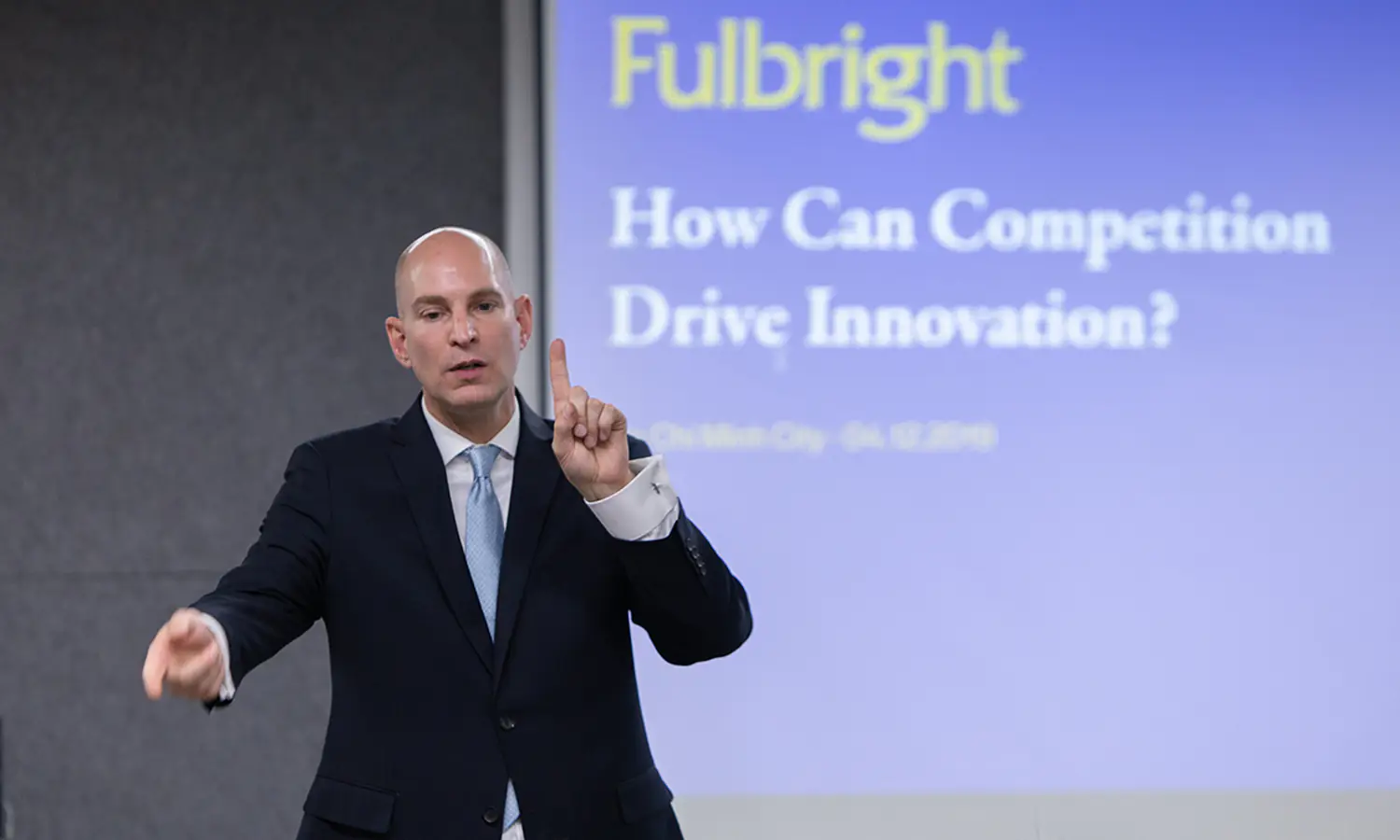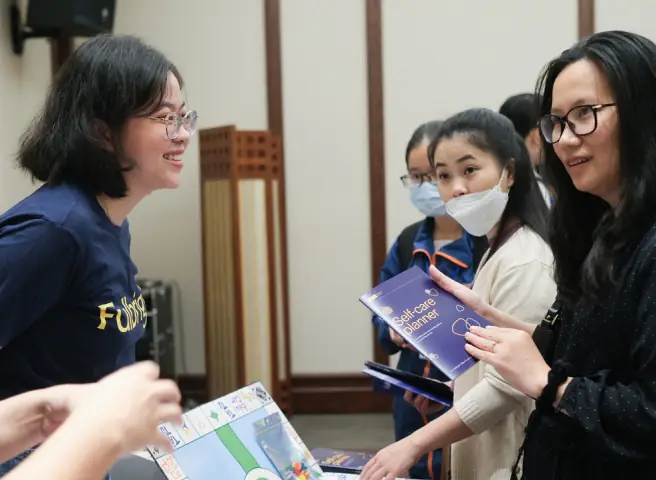
On December 4, 2019, Dr. John Branch, Clinical Assistant Professor of Business Administration and Co-Director of the Yaffe Digital Media Initiative at Stephen M. Ross School of Business visited Fulbright University Vietnam. As part of a talk series, organized by Fulbright’s Center for Entrepreneurship and Innovation, Dr. Branch delivered an amicable and engaging speech on a classic economic topic: how to win on the market.
This talk is the first of many planned by the CEI to share the expertise of leading experts in entrepreneurship and innovation to the broader Fulbright and Ho Chi Minh City community.
Competition and superior performance
“Competition is the on-going, disequilibrium-provoking process which consists of the struggle among companies for comparative advantage in production resources costs, and competitive advantage in consumer value, and there by Superior Performance,” this is a rather complex definition of competition introduced by Professor Shelby D. Hunt. Dr. Branch helped break down this concept. Simply put, a company wins when it can outperform its competitors, hence achieving “superior performance”, either by having lower production costs or higher consumer value.
The first half of any company is acquisition and deployment of production resources, which include financial, legal, physical, human, organizational and relational – the FLPHOR resources. With these resources being scarce and heterogeneous, companies compete against each other in order that their cost structure is lower than that of their competitors.
“Every day, your task as a businessperson in a company is to try to lower costs. There are two ways to lower costs: to lower the acquisition costs, or to deploy your resources more efficiently,” Dr. Branch emphasized.

Dr. Branch explaining the FLPHOR resources
The second half of a business is going to the market. As with resources, consumers and products are divergent: no two consumers or two products are the same. “When a company goes to market, we discover that different offerings in the market yield different values to different consumers”. Businesses have to attract buyers by offering exceptional consumer value, with better 4Ps – product, price, place and promotion.
Moreover, a company needs to be aware of where it is situated, whether it is enjoying superior performance and should keep going, or it is in an inferior position and needs to stop.
“Know yourself and know your competitors, which means doing research. But to be fair, the market will also tell you, especially if your company is publicly traded on the stock market. Stock analysts are not actually analyzing the stock, they analyze the performance, and then they issue advice to buy, hold or sell,” John clarified.
A question was raised by an audience member: “In a situation where we have to choose between cost reduction and value increase, which should be prioritized?” To this, Dr. Branch positively affirms a rule of thumb: always go for value. “Always a cost floor, never a value ceiling,” he said.

The audience was captivated by Dr. Branch’s speech
With production resources, there are certain limits to which cost can only be reduced to, thus the “cost floor”. However, value enhancements are limitless. At the end of the day, consumers want value maximization, not price minimization.
“If you can produce something and sell it at a very cheap price but no one wants to buy it, you’re not making any money,” John explained.
Not all inventions are innovations
In a constantly evolving and highly competitive world, businesses have no other way to achieve superior performance than to innovate. The very definition of innovation, according to Dr. Branch, stems from competition itself.
“There are two types of innovation. The first type of innovation is, ‘invention minus cost’. An innovation is when a company invents something that can lower their costs. Or, ‘innovation is equal to invention plus value’ – innovation is anything we do which is novel, new, creative and adds value.”
To illustrate this idea, Dr. Branch recalled an innovation by the fast food powerhouse – McDonald’s. Most Americans are well familiar with Drive-Thru, McDonald’s speedy service that allows customers to buy food without leaving their cars. Customers place their orders by speaking into a microphone while on the other end, an employee wears a headset to take the orders. Yet, many would be surprised to know McDonald’s is currently experimenting outsourcing this job to labor all the way in Bangalore, India. As counter-intuitive as it may sound, this is an exemplary innovation, as it helps McDonald’s cut down on their human resources costs as well as organizational costs, giving them a comparative advantage.

On the other hand, some inventions are not innovative at all. For instance, Colgate-Palmolive once launched a product that combined a toothpaste pump and a roll of dental floss. However, this was quickly pulled from the shelves, which was an evitable move according to Dr. Branch. The item was inconvenient, had no actual improvement to the product quality and consequently, it could hardly appeal to any buyer.
“If something does not add value, it’s only an invention, not an innovation. Who decides? The customers,” reiterated John.
The best advantage is sustainable advantage
Once they have successfully achieved superior performance, companies need to consider another critical question: how to keep winning. Most will lose their edge after a while, yet some enjoy leading the market for a long time.
“When it comes to business, you only are winning for a short period of time. It’s a continuous, ongoing game, it never stops. Competition is ‘dis-equilibrium’, what does it mean? – It never stands still.”
Another concept was brought to the table: sustainable advantage. Sustainable advantages have one thing in common: inimitability, being very hard to copy or emulate. This would allow companies to stay ahead of the game without being dethroned by competitors. Dr. Branch pointed out several different ways market-dominant enterprises have used to achieve such position.

The most prevalent method is utilizing legal frameworks, patenting ideas to prevent other companies from reproducing them, as applied by the pharmaceutical company Pfizer. However, this is far from being the only way. Others include complexity, like Toyota’s intricate systems that none can replicate; the secrecy of Coca Cola’s recipe; or the rarity of De Beers’ diamonds. In short, companies have to be creative with inaugurating sustainable advantages, otherwise, they will not be able to maintain their superior performance.
To summarize his speech, Dr. Branch put an emphasis on the importance of competition: “It seems that competition is a very powerful beast. Without competition, there’s not really a lot of economic advancements.”
Anh Thư







